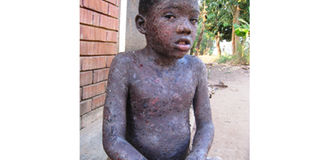Strange disease eats up children’s skin in Masaka

Nine-year-old Gideon Busulwa from Masaka has been suffering from an autoimmune skin disease since his childhood. Photo by Issa Aliga.
What you need to know:
Autoimmune diseases can affect many parts of the body. One of the common signs of the disease is inflammation, which can cause redness, heat, pain and swelling of the body.
A rare skin infection, which is fast spreading among children in Masaka District, is worrying medics who fear the disease could spread faster.
The cause of the autoimmune skin infections is not known, but, it usually affects large parts of the body.
At Masaka Regional Referral Hospital, dermatologist Dr Caroline Alitwala says that since the start of the year, she has received about five cases of children with autoimmune skin infection.
Nine-year-oldGideon Busulwa is one of them. He is said to be suffering from secondary bacterial skin infection, because of the extent to which the disease has affected his skin.
For Busulwa, it all started in 2010 when the first signs of the skin disorder started to appear on his body. Before long, it had spread to his entire body.
It resulted in inflamed skin and painful blisters. At the time, Busulwa was a primary two pupil at Kasanje Primary School, in Kabonero sub county, Masaka District.
His skin became so scary that his friends at school started isolating him and no one wanted to play with him. He was too stigmatised, and dropped out of school.
When Daily Monitor visited Busulwa, his aunt with whom he lives explained that weather conditions greatly affect a person suffering from autoimmune skin infections.
“When it is cold, he shivers a lot and yet when it is hot, he sweats uncontrollably.”
Dr Alitwala says the disease cannot be passed on from person to person, and is not genetically inherited.
“This is one of the autoimmune bullous skin diseases that represent a heterogeneous group of disorders of skin,”she explains.
She adds that antibodies induce loss of adhesion between epidermis and dermis, resulting in blister formation and extensive erosion of the skin.
Cause not known
Dr Alitwala says that it is a rare skin disease whose cause has not yet been fully established.
She explains that it usually starts to present symptoms when a person is between two and three years old, and can disappear by the time a child reaches the age of 13.
“Clusters of blisters develop in the specific areas of the body like the face, trunk, lower limbs, and they tend to appear in phases,” she says.
Dr Alitwala says that the condition can be confirmed by a skin biopsy. Although there is no known cure for these skin complications yet, Dr Alitwala notes that using sulfone, ciclosporn and corticosteroids can help reduce the blisters and itching. Good hygiene and sanitation in homes can keep some skin infections at bay.




